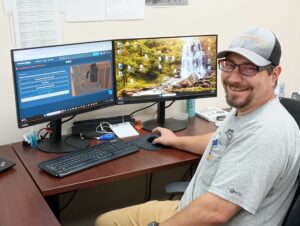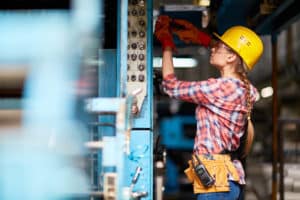Multi-family maintenance managers are struggling with staffing and under-skilled technicians. The solution? Hire for attitude, then implement digital training using videos and hands-on simulations. With the right training tools, you can assess skills to create personalized learning paths, offer flexible mobile training, and retain talent through incentives tied to course completion. Achieve faster promotions and fewer callbacks when you invest time in your team.
Working as a multi-family maintenance manager can feel like you’re plugging a dam with your finger, hoping it doesn’t burst.
With your own list of tasks, it’s hard to make time for training. The techs working under you are too few and too green, and you often have callbacks to fix what wasn’t fixed right the first time.
Sound familiar? You need maintenance techs who can hit the ground running from Day 1 and continue building their skills independently.
Managing an underskilled and understaffed workforce is stressful, but there’s a better way to build a skilled workforce from the ground up.
Why Multi-Family Maintenance Training Matters
Almost half of multi-family property owners report difficulty hiring and retaining maintenance staff. Staffing issues can lead to a whole range of additional issues, such as:
- Excessive outsourcing and increased third-party calls
- Increased callbacks
- Slow unit turnovers, impacting revenue
- Increased ticket wait times
- Increased on-the-job accidents and insurance claims
So, how do you build a highly skilled maintenance team that reduces costs, helps increase capacity, and meets tenants’ needs?
The answer lies in an effective multi-family maintenance training program that attracts the right talent, offers systematic training, and encourages career growth.
The five steps below will give you the insight and direction you need to start building your maintenance tech dream team today.
Phase 1: Attracting New Talent
Building a team of highly skilled maintenance techs starts with hiring the right people. If applicants with technical expertise aren’t available, the next best step is to hire for attitude, then train for aptitude. Look for candidates with soft skills like motivation, customer service skills, and coachability and equip them with an intensive, progressive training program to help them learn and advance quickly.
Sell a Career, Not Just a Job
Millennial and Gen Z job-seekers cite learning and development (21%) and career advancement (19%) as two of the top things they look for in a workplace.
This generation wants career guidance and mentorship from their managers, but most feel they aren’t getting it. Cast a vision for where your techs should be in six months, a year, or five years, then show them how your maintenance manager training program and advancement ladder will get them there.
Give a Pre-Hire Assessment
It can be hard to know if candidates are inflating skills in their resumes or in interviews. To find the best candidates, you can use skills assessments to determine a candidate’s skill levels before you hire them.
Keep in mind that a lack of skills doesn’t mean they won’t turn out to be a great hire with training in the long run. But a multi-family maintenance assessment is the fastest way to know if what a person wrote in their resume matches their skill set.
Phase 2: Investing in Digital-First Training
When training new techs is always a 1-on-1 experience, it’s not scalable or repeatable. Instead, you can supplement your training program with digital training and online simulations that give techs a safe way to learn independently, practice troubleshooting, and advance quickly.
There will always be elements of practical application and on-the-job training, but digital maintenance training equips learners with foundational knowledge and techniques, greatly reducing the time you need to spend with them.
Online, On-Demand Maintenance Manager Training
It’s amazing what you can learn from industry experts who have done the job themselves, from HVAC fundamentals and electrical concepts to appliances and interactive toilet troubleshooting simulations. An on-demand catalog of expert-created learning means you can deliver hundreds of hours of skilled trades training content to the homes and service trucks of your maintenance technicians.
Scale Hands-On Practice with Simulation-Based Training
Every multi-family training program must include safe, repetitive, and supervised hands-on practice. Yet, creating in-the-field teaching opportunities can be both time and resource-intensive and tough to scale.
That’s where methods such as 3D simulations come in. Simulation-based training has been used for many decades in aviation, the military, and surgical sciences. One of the greatest advantages is that it lets learners train in a risk-free environment without the risk of injury, damage to units, or the use of expensive materials. It also enables them to practice troubleshooting and learn how to properly diagnose issues, rather than relying on switching out parts to solve a problem.
Phase 3: Assessing Technician Skills
During the onboarding process, it’s important to assess a new tech’s skill level to give you better insight into your team’s strengths and weaknesses. An assessment sets a baseline for future progress. Some new hires will be more experienced than others, so gauging their knowledge level is critical to providing them with the customized training they need.
An assessment is best done by having each new team member complete a thorough, objective review that accurately ranks their knowledge in specific key areas. For example, Interplay Learning’s multi-family maintenance training assessment quizzes new hires on proficiencies such as:
- Electrical Meter Use
- Measuring Input (Gas Appliances)
- Verifying Proper Airflow
- Pipe Joining and Installation
- Fixture Installation
With the results, Interplay helps you build a training program with learning paths to target the specific skills they need to strengthen.
Phase 4: Offering Efficient, Effective Training
Once new hires are on board, you want to assign them customized training based on their skills assessment results and end goals. You can use Interplay’s course and path recommendations tocreate a personalized sequence of courses, simulations and other educational materials. This helps you provide faster, more efficient training to build the specific skills they need rapidly.
Flexible Learning
Flexibility is key. Look for a learning platform that offers bite-sized learning modules your employees can access on any device. Being able to access training on a laptop, tablet, VR or even a mobile app creates flexibility for techs to learn new skills whenever and wherever.
LMS Integration
Many large-scale enterprise maintenance companies are already committed to a Learning Management System (LMS) for training their employees. When this is the case, you can choose tointegrate Interplay’s training content into your existing system. Having a one-stop shop where your employees log in for training eliminates the confusion and redundancy of using multiple platforms.
Phase 5: Developing and Retaining Talent
Growing your technicians’ skill levels helps your company stay competitive and helps you retain a talented team of technicians. Investing in employee training and improving job satisfaction increases retention rates and reduces workforce turnover for your organization.
Two proven strategies for retaining technicians are offering incentives and tracking:
1. Build an Incentive Program
To incentivize continuous learning and retention, why not use the completion of a learning path as a benchmark for “leveling” or earning a raise? When you reward your techs with an incentive program, chances are they will train more than you anticipate because the goals are tangible, attainable and help to advance their careers at the same time.
2. Benchmark and Track Progress
To make maintenance training and education effective for your dream team of technicians, tracking their progress is a must. To accurately gauge a techs’ progress, reassess their skills as they advance along their learning paths. This will also help them to identify areas where they would like to grow and guide more targeted training.
Look for an integrated training system that includes:
- The ability to create custom learning pathways for each employee or each role they would like to attain (e.g., tech I, tech II, supervisor).
- A way to study for and earn industry-recognized credentials relevant to their job in multi-family maintenance.
- A comprehensive dashboard for tracking the progress of hundreds of employees across locations and levels.
The ability to track training engagement and progress offers benefits to both managers and employees. While a tech’s learning patterns help direct learning paths and skill levels, they can also be factored into long-term decisions, such as which team members to promote or give raises.
Multi-Family Maintenance Training Program Story: J.C. Hart Company
J.C. Hart Company needed a better way to train its maintenance team. New associates often found traditional in-person classes overwhelming, while seasoned associates were frustrated by repeating the same courses without learning anything new. The company wanted training that could adapt to each technician’s skill level, build confidence, and support career growth.
With Interplay Learning, J.C. Hart introduced personalized assessments, skill-based learning pathways, and hands-on 3D and VR simulations. Technicians now practice repairs in a safe environment, follow structured tracks like Maintenance Tech 1 and Tech 2, and train in short, flexible sessions that fit their schedules.
The results have been clear: fewer callbacks, faster promotions, and more confident technicians. Career advancement timelines have been cut nearly in half — from 18-24 months to as little as 12 months. The program also helps them recruit and retain younger talent, who are excited by modern VR training and motivated to grow within the company.
Explore Cutting-Edge Maintenance Training Options
When you offer digital, hands-on learning opportunities and training incentives, your techs are motivated to improve their skills and build their knowledge. Instead of burning yourself out training techs who turn over quickly, you can scale your training and put techs on a rewarding training journey and career path.
Innovative maintenance training helps you attract, onboard, and retain techs more effectively, with less handholding. A comprehensive, scalable training program is the key to reducing callbacks and cutting costs.
Stop waiting for the right talent and start building your own workforce today.
Access our full multi-family maintenance training guide or explore a demo to see first-hand how Interplay Learning can revolutionize your training.




